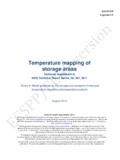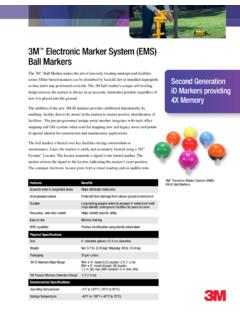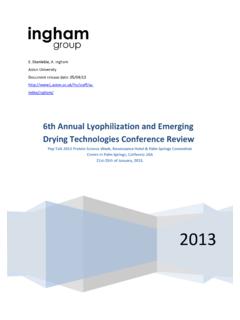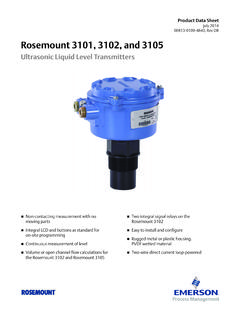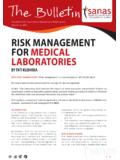Transcription of IQCP: Performing a Risk Assessment - QCNet
1 iqcp : Performing a Risk Assessment Greg Cooper, CLS, MHA, CQA Objectives Identify the mandatory components of an iqcp Discuss tools and resources to identify risks Evaluate hazards to determine their risk level Identify mitigating activities to reduce risk Getting Started iqcp began from the question of QC frequency Doing the right QC An honest thorough iqcp could reveal the need to increase QC frequency1 Interest for most laboratories driven by: Need to replace EQC by Jan 1, 2016 Manufacturer recommendation for QC frequency less than CLIA minimum1 Manufacturer makes no QC recommendation1 1 Getting Started Establish scope of the QCP Which tests in the lab will Meet CLIA minimum Exceed CLIA minimum Have an iqcp Required/not required Multiple instruments in different locations QCP/ iqcp is test/device/location specific2 2 Guiding Principles Keep your iqcp on point and simple Don t over-complicate the work Do your homework DO NOT be dependent on manufacturer templates CMS will be looking for an Assessment by the lab (Brochure 12)
2 Give the iqcp an HONEST effort Use Excel or Word to create simple forms that summarize and highlight key findings and decisions DO NOT recreate the product insert or instrument manual in a risk analysis format Not a risk analysis just a fruitless exercise in creative writing The Key to a Good Risk Assessment Build a really good iqcp Team Your iqcp Team 5-7 people authorized by management to build a QCP Assign authority, responsibilities, accountability Core characteristics of members People who can make decisions and finish a project Inquisitive & creative thinkers Knowledge of the process/ procedure Open-minded Stakeholder Mandatory Components of the iqcp 3-5-3 3 3 Mandatory Phases of Testing Pre-Analytic Analytic Post-Analytic 5 5 Mandatory Areas to Include Specimen People Instrument Reagent Environment 3 3 Mandatory Sections of the iqcp Risk Assessment QC Plan Monitoring Effectiveness.
3 Side notes 1 iqcp for each location of testing Cannot go below manufacturer s recommendation Can t use manufacturer s data or template iqcp alone must contain your data and match your process Must have data to support frequency Risk Analysis 14 Process Map: Example 15 Some sources of risk Communication processes Knowledge and competency of test operators Management commitment Outside influences Resources Technical components Process/Procedure Financial decisions based on cost not quality 16 Fishbone Diagram Incorrect Test Result1 Samples2 Operator3 Reagents5 Measuring System4 Laboratory EnvironmentSample IntegritySample Presentation- Lipemia- Hemolysis- Interfering subtances- Clotted- Incorrect tube- Bubbles- Inadequate volumeOperator CapacityOperator staffingAtmospheric EnvironmentUtility Environment- Training- Competency- Short staffing- Correct staffing- Dust- Temperature- Humidity- Electrical- Water quality- PressureReagent Degradation- Shipping- Storage- Used past expiration- PreparationQuality Control Material Degradation- Shipping- Storage- Used past
4 Expiration- PreparationCalibrator Degradation- Shipping- Storage- Use past expiration- Preparation Instrument FailureInadequate Instrument Maintenance- Software failure- Optics drift- Electronic instability- Dirty optics- Contamination- ScratchesIdentify Potential HazardsCLSI: Laboratory Quality Based on Risk Management. EP23-A. 2011 A Fishbone Approach 1 Incorrect Test Result 2 3 4 5 1 2 3 4 5 1 2 3 4 5 Pre-Analytical Phase Analytical Phase Post-Analytical Phase 1 Samples 2 People 3 Reagent 4 Environment 5 - Instrument Test System Pre-Analytical Calibration Calibration Verification Maintenance daily, w / m / semi-annual Electrical Monitoring, Surge Protection Dedicated Circuit Water Supply (if required) Water quality Water integrity (air) Humidity (mfr requirement) Temp. (mfr requirement) PT Performance Calibration of ancillary equip Analytical Consumables (quality) Reagent dispense Sample dispense Reaction Chamber Temperature Measurement Filter wheel Light source integrity Clot detection Interfering substances Quality Determination QC approach used QC materials used QC frequency QC Rules Patient risk (# patients between QCs) Post-Analytical Results: review / approve Result Transmission Retrospective Review Trend Analysis Sigma Metrics Frequency of recalibration Freq.
5 Of Device Failures Verification of Test Results Information Gathering / Analysis Test System for POCT Pre-Analytical Calibration Calibration Verification Maintenance daily, w / m / semi-annual Electrical Monitoring, Surge Prot Dedicated Circuit, Battery Water Supply (if required) Water quality Water integrity (air) Humidity (mfr requirement) Temp. (mfr requirement) PT Performance Calibration of ancillary equip Analytical Consumables (quality) Reagent dispense Sample dispense Reaction Chamber Temperature, Black Box Measurement Filter wheel Light source integrity Clot detection Interfering substances Quality Determination QC approach used QC materials used QC frequency QC Rules Patient risk (# patients between QCs) Post-Analytical Results: review / approve Result Transmission Test Report Retrospective Review Trend Analysis Sigma Metrics Frequency of recalibration Freq.
6 Of Device Failures Verification of Test Results Analysis Brainstorming a POCT Test PROCESS MAPPING OR FISHBONE DIAGRAM Analytical Reaction Chamber Black Box Measurement Interfering Substances Quality Determination QC approach used QC materials used QC frequency Patient risk (# patients between QCs) Possible Hazard Points What Can Go Wrong? Analysis Brainstorming a POCT Test PROCESS MAPPING OR FISHBONE DIAGRAM Analytical Reaction Chamber Black Box Measurement Interfering Substances Quality Determination QC approach used QC materials used QC frequency Patient risk (# patients between QCs) Possible Hazard Points Does the device manual or the product insert describe in detail the analytical sequence? Does the product insert, the device manual or the manufacturer describe in sufficient detail how the function checks work and are themselves Has the manufacturer provided a product reliability score or the mean time between failure?
7 Analysis Brainstorming a POCT Test PROCESS MAPPING OR FISHBONE DIAGRAM Analytical Reaction Chamber Black Box Measurement Interfering Substances Quality Determination QC approach used QC materials used QC frequency Patient risk (# patients between QCs) Possible Hazard Points Does the product How is the patient cleared for interfering substances? Analysis Brainstorming a POCT Test PROCESS MAPPING OR FISHBONE DIAGRAM Analytical Reaction Chamber Black Box Measurement Interfering Substances Quality Determination QC approach used QC materials used QC frequency Patient risk (# patients between QCs) Possible Hazard Points Does the product How is the patient cleared for .. What QC modality is used? Function checks only? Electronic QC only? Traditional QC? First party, second party or third party controls used?
8 Embedded control used? Liquid or solid phase QC? Shortcomings? How frequently is QC run? Can errors/mistakes/failures/hazards be detected immediately? How are QC limits established? What QC rules are used? How many patient test results are reported between QC testing events? Grading and Ranking Risk Can use FMEA approach Grade (score 1-5 or 1-10) for occurrence, severity, detection Multiply scores to get Risk Priority Number (RPN) Rank for importance by RPN and Acceptance criteria How much risk is acceptable? Set by team Alternative grading system Negligible Minor Serious Critical Catastrophic Frequent not ok not ok not ok not ok not ok Probable ok not ok not ok not ok not ok Occasional ok ok ok not ok not ok Remote ok ok ok ok not ok Inconceivable ok ok ok ok ok Severity of harm Probability Adapted from ISO 14971 An EXAMPLE HIV Rapid Plasma Test Potential hazards identified by iqcp team plasma only stable up to 7 days is critical read at 20-40 minutes post inoculation in controls do not verify reactive/non-reactive controls are specifically formulated for the test party external controls are tested once per week HIV Rapid Plasma Test Consequences (Severity)
9 Associated with a bad HIV result A false positive could lead to broken relationships or families A false negative could lead to new infections for unwary partners EDTA plasma only risks identified by iqcp team Bad result or no result with other anticoagulants Assessment by iqcp team Probability of occurrence is estimated to be remote Consequences of a bad result if reported and acted on can be critical and mitigation by iqcp team Risk acceptable Mitigation: None required Evaluation Negligible Minor Serious Critical Catastrophic Frequent not ok not ok not ok not ok not ok Probable ok not ok not ok not ok not ok Occasional ok ok ok not ok not ok Remote ok ok ok ok not ok Inconceivable ok ok ok ok ok Severity of harm Probability Adapted from ISO 14971 First party external controls are tested once per week risks identified by iqcp team Error or faults in the test system are not detected when they occur Once per week testing of control materials does not allow adequate ongoing monitoring of accuracy and precision as required by CLIA Assessment by iqcp team Probability of errors or faults is estimated to be occasional Failure to detect error or fault can have critical consequences and mitigation by iqcp team Risk not acceptable Mitigation: Use third party controls.
10 Test more frequently than once per week Alternative grading system Negligible Minor Serious Critical Catastrophic Frequent not ok not ok not ok not ok not ok Probable ok not ok not ok not ok not ok Occasional ok ok ok not ok not ok Remote ok ok ok ok not ok Inconceivable ok ok ok ok ok Severity of harm Probability Adapted from ISO 14971 To summarize: Form a team Set the scope of the QCP Which tests will have an iqcp Gather relevant information Perform the analysis Identify hazards and prioritize the importance Evaluate the risk, decide on and implement mitigations To summarize Keep it simple Stay on point Do not rely solely on manufacturer templates When doing the analysis and making decisions ALWAYS be guided by what is best for your patients. Reference materials CMS iqcp Link: CLIA Brochure 12: CLIA Brochure 13: EP23-A Laboratory Quality Control Based on Risk Management, Clinical and Laboratory Standards Institute, Wayne PA 35 THANK YOU

